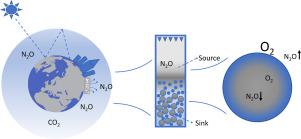Water Research ( IF 11.4 ) Pub Date : 2021-04-19 , DOI: 10.1016/j.watres.2021.117159 Edward J.H. van Dijk , Mark C.M. van Loosdrecht , Mario Pronk

|
The nitrous oxides emission was measured over 7 months in the full-scale aerobic granular sludge plant in Dinxperlo, the Netherlands. Nitrous oxide concentrations were measured in the bulk liquid and the off-gas of the Nereda® reactor. Combined with the batch wise operation of the reactor, this gave a high information density and a better insight into N2O emission in general. The average emission factor was 0.33% based on the total nitrogen concentration in the influent. The yearly average emission factor was estimated to be between 0.25% and 0.30%. The average emission factor is comparable to continuous activated sludge plants, using flocculent sludge, and it is low compared to other sequencing batch systems. The variability in the emission factor increased when the reactor temperature was below 14 °C, showing higher emission factors during the winter period. A change in the process control in the winter period reduced the variability, reducing the emission factors to a level comparable to the summer period. Different process control might be necessary at high and low temperatures to obtain a consistently low nitrous oxide emission. Rainy weather conditions lowered the emission factor, also in the dry weather flow batches following the rainy weather batches. This was attributed to the first flush from the sewer at the start of rainy weather conditions, resulting in a temporarily increased sludge loading.
中文翻译:

大型市政好氧颗粒污泥中的一氧化二氮排放
在荷兰Dinxperlo的全规模好氧颗粒污泥厂中,测量了7个月内的一氧化二氮排放量。在Nereda®反应器的散装液体和尾气中测量了一氧化二氮的浓度。结合反应器的分批操作,可以提供较高的信息密度和对N 2的更好了解一般为O排放。基于进水中的总氮浓度,平均排放因子为0.33%。年平均排放因子估计在0.25%至0.30%之间。平均排放因子与使用絮凝污泥的连续活性污泥工厂相当,并且与其他测序分批系统相比较低。当反应堆温度低于14°C时,排放因子的可变性增加,表明冬季排放因子更高。冬季过程控制的改变降低了可变性,将排放因子降低到与夏季相当的水平。在高温和低温下可能需要不同的过程控制,以实现始终如一的低一氧化二氮排放。阴雨天气降低了排放因子,在阴雨天气批次之后的干旱天气批次中也是如此。这归因于阴雨天气开始时下水道的第一次冲洗,导致污泥负荷暂时增加。











































 京公网安备 11010802027423号
京公网安备 11010802027423号